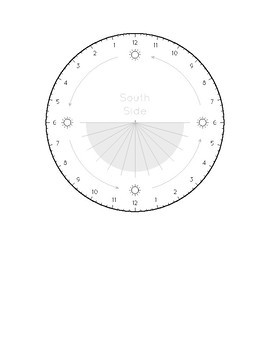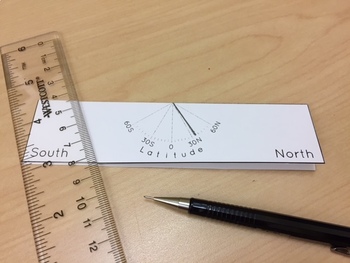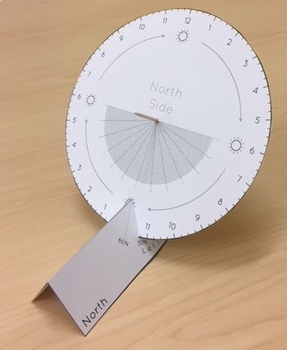- PDF
Description
This is a very simple paper sundial for students to cut out and assemble. It requires only cutting out a circle and a rectangle, cutting one slot, and poking one hole. This "equatorial" design of sundial consists of a disk with an axial gnomon (or "shadow stick"), and reflects in physical form the circle of the sun in the sky. The tilted disk lines up with the daily circle of the sun in the sky, and the gnomon points at the North Star (or the South Celestial Pole if you live in the southern hemisphere), meaning it is parallel to the axis of the earth. Note that unlike sundials in other orientations, the marks on the equatorial dial are evenly spaced, reflecting the fact that the sun marches steadily around its circle, once around each day.
This dial can be adapted to any latitude, except near the poles, simply by cutting the slot in the base at the appropriate angle.
To make the dial, print out the design on card stock. The two faces of the dial are aligned so that you should be able to print it as one double-sided piece of paper, and cut out one double-sided dial, although I find that sometimes printers don't align the two sides very well. You may prefer to print and cut the two sides of the dial separately, and then glue them back-to-back. After cutting out the rectangular base, fold the base in half along the centerline. Scoring the fold line before folding with a ruler and a pin or dull blade of some kind helps to make a crisp, straight fold. Next, make an incision in the folded base at the appropriate angle for your latitude. Fasten a toothpick or pin in the center of the dial, and place the dial in the slot, with the north side facing north.
To use the dial, it needs to be placed in the sunshine with the gnomon pointing at the North Star (in the northern hemisphere). In the summer, the sun should shine on the northern face all day long. In winter, it should shine on the southern face, and at the equinoxes, it should pass exactly around the edge of the dial.





